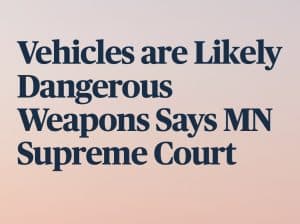 Vehicles are Likely Dangerous Weapons Says MN Supreme Court
Vehicles are Likely Dangerous Weapons Says MN Supreme Court
In recent summers, car takeover events received significant press in the twin cities. A takeover is when a group of people get together with several vehicles and occupy a street, intersection, or parking lot, thus taking over the area. People do not like the ruckus. It can disrupt traffic. And, the vehicles can cause property damage when they start burning tires and doing donuts on the pavement. We blogged here about prosecutors responding to this summer-time activity with second degree riot charges.
Defense attorneys began to challenge such charges by arguing that there is not probable cause to believe vehicles fit the definition of dangerous weapons in these scenarios because the cars were operated in a controlled manner. After winning at the district court on such a challenge, the Minnesota Court of Appeals said no dice. It addressed the probable cause challenge in State v. Abdus-Salam and reversed the district court. The court reasoned that there was enough to meet the standard of probable cause because prosecutors provided enough evidence that “defendant knew that the cars would be driven with passengers hanging from them and in a reckless manner dangerously close to onlookers during an illegal intersection ‘take-over.’”
The Minnesota Supreme Court looked at two questions: (1) what does “likely” mean in the context of the statutory definition of dangerous weapon; and (2) did the district court err when dismissing the complaint for lack of probable cause.
For the statutory definition analysis of dangerous weapon, the court highlighted the pertinent part of “other device or instrumentality that, in the manner it is used or intended to be used, is calculated or likely to produce death or great bodily harm”. The court then focused on “likely” within that definition as the key term. After spending several pages on the historical analysis and definitions, the court pitted the defense’s interpretation of “likely” as “highly probable” and the prosecution’s interpretation as “something less than or equal to probable”. As a shot to the parties, the court noted neither side offered convincing support for its position as to what the legislative intent was; and ultimately held the plain meaning of likely means probable or reasonably expected in the manner used for dangerous weapons.
After siding with the prosecution on the meaning of “likely”, the Minnesota Supreme Court determined the district court erred when dismissing the complaint for lack of probable cause. The buck does not stop there, however. The defense can still take the case to trial and see if a judge or jury agrees that the heightened standard of proof beyond a reasonable doubt is met for whether vehicles were likely to produce death or great bodily harm in the way the cars were used.
It will be interesting to see how these cases shake out at trial, whether prosecutors will continue to use second degree riot charges, and whether the legislature will change the statutory scheme to address vehicle takeovers. Even though the prosecution won this case at the Minnesota Supreme Court, they know it is not a perfect statute to charge these cases out. It is what they have for now, but they for sure want something better.
Robert H. Ambrose is a criminal defense lawyer and DUI lawyer in the Twin Cities and the state of Wisconsin. Super Lawyers named him a Super Lawyer for the past three years and a Rising Star in the preceding six years. He is an adjunct professor at the University of Minnesota Law School. DWI Lawyer Minneapolis MN; Criminal Defense Lawyer Wisconsin; and Criminal Appeals Attorney Minnesota.
